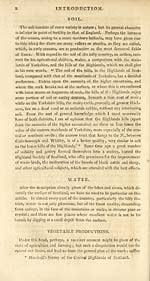Gazetteer of Scotland
(21) Page ix
Download files
Complete book:
Individual page:
Thumbnail gallery: Grid view | List view

INTRODUCTION. it
FORESTS.
The ancient forests of Scotland have been" greatly diminished in ex-
tent, while our improvident ancestors never thought of replacing them
by plantations. Of the ancient Sylva Caledonia, or Caledonian forest,
the most considerable remains are in the districts of Marr aud Glentanar;
in Rannoch ; in Glenmore and Strathspey ; and in Alfarig, in Ross-shire.
The fir is the most common wood \ but the oak and other deciduous
trees are not wanting. These forests, some of which extend no less than
30 or 4o miles in length, would, doubtless, be a source of great riches to
the proprietors, and to the country at large, did ntt the want of roads,
and the distance from the sea, preclude the possibility of land carriage ;
and the plan of floating down the rivers is not so practicable, owing to
the risk of being shivered by the frequent and high falls. Notwithstand-
ing these obstacles, however, several companies have succeeded in float-
ing upon the Spey and Dee, by cutting canals where the falls are so high
jts to injure the wood*
CLIMATE,
Situated in the midst of a great ocean, and in such a northern latitude,
Scotland cannot boast of a regular climate. In different places the cli-
mate varies considerably. From its insular situation, however, the cold
in winter is not so intense as in similar latitudes on the Continet ; and
in summer, the heat, especially on the coast, is moderated by the sea
breezes. In winter, the thermometer seldom sinks so low as it does in
the S. of England ; but the length cf that season is generally more pro-
tracted. Like other mountainous countries* it is much subject to
rain ; and the mountains being generally highest on the W. coast, and
declining towards the E., has been thought to be the cause why the
western coast is most rainy. We are inclined to believe this, owing to
the prevalence of the west wind, which brings humidity from the Atlan«*
tic ocean. Clouds of the sea are fraught with vapour, in proportion to
the extent of the sea over which they pass ; because they are continual-
ly absorbing the exhalations from its surface. Hence it follows; that the
same tract of windy weather, and the same quantity of haar or fog im-
ported from the ocean, will not produce so much rain on the E. as on
the W. coasts. During the spring months, however, the W. coasts have
the advantage ; for the easterly winds in that season are generally frosty*
by which vegetation is retarded, and the E. coasts are almost deprived
of the most pleasant season of the year. As Scotland possesses few o$*
scarcely any marshy districts, the climate is more salubrious than in the
low and fenny counties of England. Since the greater part of the mar-
&hy grounds have been drained, agues and other diseases, arising from pu.«
tiid or marsh miasmata, have almost disappeared.
FORESTS.
The ancient forests of Scotland have been" greatly diminished in ex-
tent, while our improvident ancestors never thought of replacing them
by plantations. Of the ancient Sylva Caledonia, or Caledonian forest,
the most considerable remains are in the districts of Marr aud Glentanar;
in Rannoch ; in Glenmore and Strathspey ; and in Alfarig, in Ross-shire.
The fir is the most common wood \ but the oak and other deciduous
trees are not wanting. These forests, some of which extend no less than
30 or 4o miles in length, would, doubtless, be a source of great riches to
the proprietors, and to the country at large, did ntt the want of roads,
and the distance from the sea, preclude the possibility of land carriage ;
and the plan of floating down the rivers is not so practicable, owing to
the risk of being shivered by the frequent and high falls. Notwithstand-
ing these obstacles, however, several companies have succeeded in float-
ing upon the Spey and Dee, by cutting canals where the falls are so high
jts to injure the wood*
CLIMATE,
Situated in the midst of a great ocean, and in such a northern latitude,
Scotland cannot boast of a regular climate. In different places the cli-
mate varies considerably. From its insular situation, however, the cold
in winter is not so intense as in similar latitudes on the Continet ; and
in summer, the heat, especially on the coast, is moderated by the sea
breezes. In winter, the thermometer seldom sinks so low as it does in
the S. of England ; but the length cf that season is generally more pro-
tracted. Like other mountainous countries* it is much subject to
rain ; and the mountains being generally highest on the W. coast, and
declining towards the E., has been thought to be the cause why the
western coast is most rainy. We are inclined to believe this, owing to
the prevalence of the west wind, which brings humidity from the Atlan«*
tic ocean. Clouds of the sea are fraught with vapour, in proportion to
the extent of the sea over which they pass ; because they are continual-
ly absorbing the exhalations from its surface. Hence it follows; that the
same tract of windy weather, and the same quantity of haar or fog im-
ported from the ocean, will not produce so much rain on the E. as on
the W. coasts. During the spring months, however, the W. coasts have
the advantage ; for the easterly winds in that season are generally frosty*
by which vegetation is retarded, and the E. coasts are almost deprived
of the most pleasant season of the year. As Scotland possesses few o$*
scarcely any marshy districts, the climate is more salubrious than in the
low and fenny counties of England. Since the greater part of the mar-
&hy grounds have been drained, agues and other diseases, arising from pu.«
tiid or marsh miasmata, have almost disappeared.
Set display mode to: Large image | Transcription
Images and transcriptions on this page, including medium image downloads, may be used under the Creative Commons Attribution 4.0 International Licence unless otherwise stated. ![]()
| Gazetteers of Scotland, 1803-1901 > Gazetteer of Scotland > (21) Page ix |
|---|
| Permanent URL | https://digital.nls.uk/97414814 |
|---|

